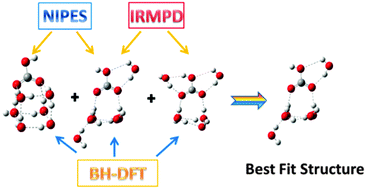Examining the structural evolution of bicarbonate–water clusters: insights from photoelectron spectroscopy, basin-hopping structural search, and comparison with available IR spectral studies†
Abstract
Bicarbonate plays a crucial biochemical role in the physiological pH buffering system and also has important atmospheric implications. In the current study, HCO3−(H2O)n (n = 0–13) clusters were successfully produced via electrospray ionization of the corresponding bulk salt solution, and were characterized by negative ion photoelectron spectroscopy and theoretical calculations. Photoelectron spectra reveal that the electron binding energy monotonically increases with the cluster size up to n = 10 and remains largely the same after n > 10. The photo-detaching feature of the solute HCO3− itself, which dominates in the small clusters, diminishes with the increase of water coverage. Based on the charge distribution and molecular orbital analyses, the universal high electron binding energy tail that dominates in the larger clusters can be attributed to the ionization of water. Thus, the transition of ionization from the solute to the solvent at a size larger than n = 10 has been observed. Extensive theoretical structural search based on the basin-hopping unbiased method was carried out, and a plethora of low energy isomers have been obtained for each medium and large-sized cluster. By comparing the simulated photoelectron spectra and calculated electron binding energies with the experiments, as well as by comparing the simulated infrared spectra with previously reported IR spectra, the best fit structures and the structural evolutionary routes are presented. The nature of bicarbonate–water interactions is mainly electrostatic as implied by electron localization function (ELF) analysis.


 Please wait while we load your content...
Please wait while we load your content...